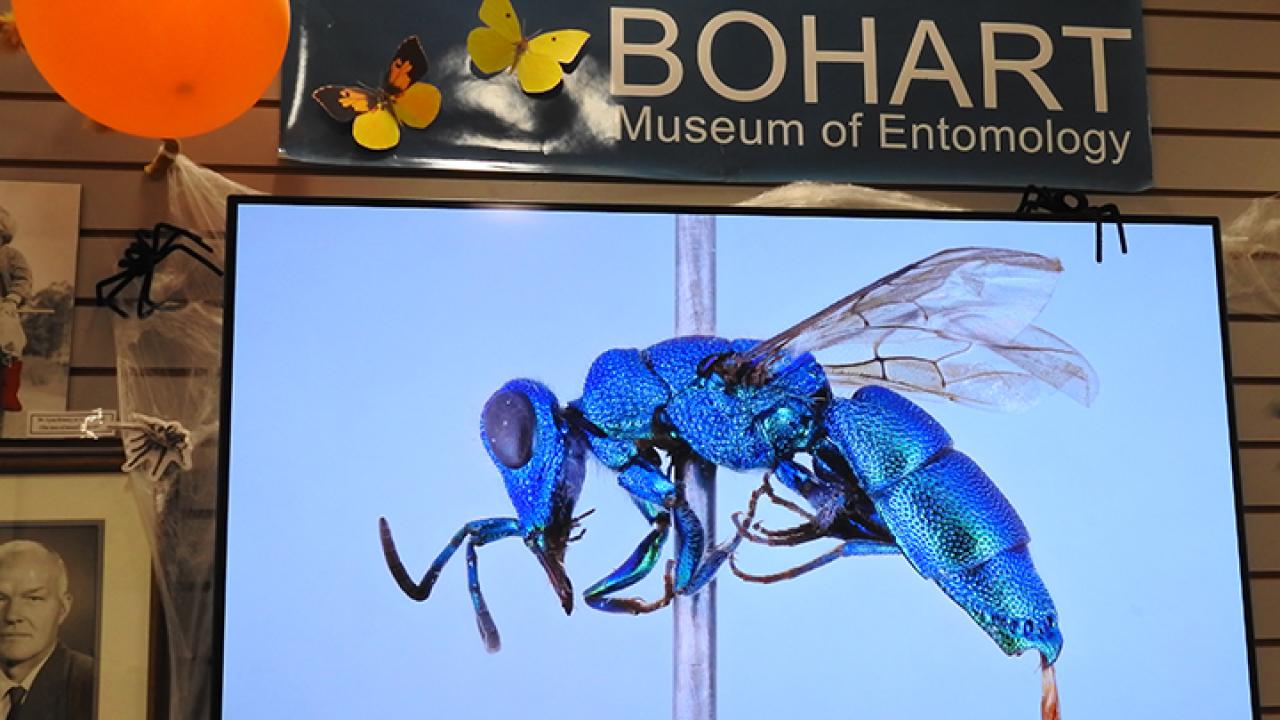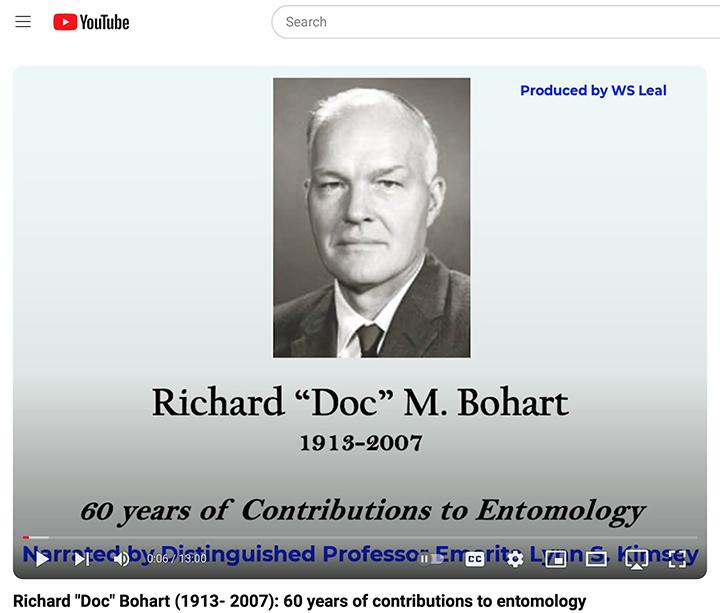
Bohart Museum Open House on Saturday, Sept. 28
Theme: 'Museum ABCs: Arthropods, Bohart and Collecting'

The Bohart Museum of Entomology will host an open house, "Museum ABCs: Arthropods, Bohart and Collecting," from 1 to 4 p.m., Saturday, Sept. 28, in Room 1124 of the Academic Surge Building, 455 Crocker Lane.
The event, open to the public, is free and family friendly. Parking is also free.
"We will have an overview of terrestrial arthropods which encompasses everything from insects, arachnids, millipedes, isopods and centipedes," said Tabatha Yang, education and outreach coordination. "We will also showcase some of the trapping/catching methods we use, for example, nets, lights, pitfall traps and malaise traps."
Pinning, spreading and curation demonstrations are planned "so people know how to take care of and preserve a dead arthropod for research or for a personal collection," Yang said. "People sometimes find a dead dragonfly or a butterfly on the ground and we often get asked how they can preserve it."
"We also get asked a lot of questions about our own collection and why the specimens don't decay," she added. "We will highlight the different curation techniques from pinning, point mounting, preserving in alcohol and mounting on slides."
Also planned is a tribute to the late UC Davis professor Richard "Doc" Bohart (1913-2007), who founded the insect museum in 1946, served as the first director, and compiled 32 years on the UC Davis entomology faculty, Sept. 28 is his birthday anniversary. Richard began collecting butterflies at age 7 and "he and his brother George 'Ned' Bohart collected butterflies for a local collector to earn pocket money," according to UC Davis distinguished professor emerita Lynn Kimsey, who directed the Bohart Museum for 34 years until her retirement on Feb. 1, 2024.
Bohart attended UC Berkeley, receiving three degrees in entomology culminating in his doctorate in 1938. He joined the UC Davis faculty in 1946 and chaired the Department of Entomology from 1956 to 1965. He taught general entomology, medical entomology, systematics, and agricultural entomology.

Kimsey, his last graduate student, remembers him in the audio of a newly produced video by Walter Leal, UC Davis distinguished professor of molecular and cellular biology and former chair of the UC Davis Department of Entomology. Kimsey provides the narrative and images. Leal added excerpts from a 1996 Aggie Video production when Kimsey interviewed Bohart. (See https://youtu.be/3YqnK-CpbJE)
"His teaching and collecting activities resulted in the development of one of the finest collections of stinging wasps in the world in the Bohart Museum of Entomology," Kimsey said. "A great deal of this material was obtained through his collecting and that of his students. During his tenure, the museum collection grew from 500 specimens to 7 million, a span of some 60 years. Chancellor James Meyer dedicated the entomology museum in his name in 1983. The R. M. Bohart Museum moved into a new building in 1994 and was dedicated by Chancellor Larry Vanderhoef."
According to the Academic Senate's tribute, Bohart "contributed substantially to the world literature of the insect Order Hymenoptera, which included two landmark books, Sphecid Wasps of the World (with A. S. Menke), and The Chrysidid Wasps of the World (with L.S. Kimsey), as well as 230 journal articles and four other books on wasps and mosquitoes, including the second and third editions of The Mosquitoes of California (the second with Stanley B. Freeborn and the third with Robert K. Washino). During his career, he described more than 200 new species and genera of insects."
At the open house, plans call for a birthday cake celebrating his 110th birthday anniversary. A sheet birthday cake will be served.

The Bohart Museum is now the home of a global collection of eight million insects; a live petting zoo (including Madagascar hissing cockroaches, stick insects and tarantulas); and an insect-themed gift shop, stocked with T-shirts, hoodies, jewelry, books, posters, and collecting equipment. Museum director is professor and arachnologist Jason Bond, the Evert and Marion Schlinger Endowed Chair in Insect Systematics, UC Davis Department of Entomology and Nematology, and associate dean of the UC Davis College of Agricultural and Environmental Sciences.
Entomologist Jeff Smith curates the Lepidoptera collection, estimated at 750,000 specimens. At the open house, he will demonstrate and discuss the various steps of relaxing, pinning, spreading, and labeling moths and butterflies.
A Bohart volunteer since 1998, Smith has spread the wings of some 180,000 moth and butterflies, typically 6,000 or more moths and butterflies each year for the past 30-plus years. He has crafted and donated some 2,475 wooden specimen drawers, including 110 so far this year.
He also has donated some 100,000 specimens (primarily butterflies, moths but a few other insects, including beetles) to the Bohart Museum. Lately Smith has been redoing the header labels in the unit trays for much of the Lepidoptera collection, "making the new ones in the better format where the geographic ranges of the various species and subspecies are on the label. This is so helpful when it comes to placing new material into the collection."

Smith received a highly competitive Friend of the College Award from the UC Davis College of Agricultural and Environmental Sciences in 2015. “You could not ask for a better friend than Jeff Smith,” said nominator Lynn Kimsey. He has “brought us international acclaim and saved us $160,000 through donations of specimens and materials, identification skills and his professional woodworking skills. This does not include the thousands of hours he has donated in outreach programs that draw attention to the museum, the college and the university.”
“When Jeff was working for Univar Environmental Services, a 35-year career until his retirement in 2013, he would spend some of his vacation days at the museum. Over the years Jeff took over more and more of the curation of the butterfly and moth collection. He took home literally thousands of field pinned specimens and spread their wings at home, bringing them back to the museum perfectly mounted. To date he has spread the wings on more than 200,000 butterflies and moths. This translates into something like 33,000 hours of work!”
Kimsey praised Smith for completely reorganizing the butterfly and moth collection. “It's no small feat to rearrange this many specimens, housed in roughly one thousand drawers,” she said. “Many thousands of the specimens needed to be identified, and the taxonomy required extensive updating and reorganization.” (See news story)
